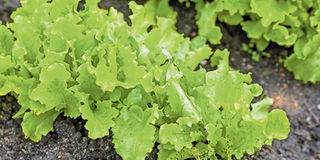Agronomist's notebook: Growing the nutritious, leafy lettuce

Lettuce is mainly consumed as salad, though the loose leaves are used in preparing sandwiches in hotels and restaurants. FILE PHOTO | NMG
What you need to know:
- The vegetable is mainly consumed as salad, though the loose leaves are used in preparing sandwiches in hotels and restaurants.
- Lettuce thrives well both in the open field and in a greenhouse. It’s planted by first raising the seedlings in a nursery, which are usually ready for transplanting after 3-4 weeks.
- Mulching should be done to conserve moisture and buffer the growth of weeds and keep the heads free from soil splashes.
- Lettuce is harvested by cutting off the head using a sharp knife preferably early in the morning or late in the evening to prevent moisture loss.
One of the crops gaining popularity among farmers is lettuce, a leafy vegetable in Asteraceae family, which matures 45-60 days.
It’s a highly nutritious vegetable that helps to cut cholesterol level hence it assists in weight management.
There are two major varieties of lettuce, that is the heading and non-heading. The heading variety tends to form a compacted head like cabbages while the non-heading one has loose leaves.
The green leaves are the edible part of the crop though there is also a purple non-heading lettuce.
The vegetable is mainly consumed as salad, though the loose leaves are used in preparing sandwiches in hotels and restaurants.
Lettuce is little known in most households in Kenya, which makes it less consumed though it is slowly gaining acceptance.
I encountered one of the farmers growing the crop recently, and her major cry is that the market is small making farmers incur losses. The high perishability of the crop adds to farmers’ woes.
Lettuce thrives well both in the open field and in a greenhouse. It’s planted by first raising the seedlings in a nursery, which are usually ready for transplanting after 3-4 weeks.
The land should be prepared to a fine tilth and well-composted manure applied. The ideal spacing is 30 by 30cm or 25 by 25cm depending on the variety and the nutritional status of the soil.
COMPETITION FOR NUTRIENTS
The crop does well in a wide range of soils that should be well-drained, have adequate moisture for development of solid heads, have a pH range of 5.5–6.5 and the temperatures should be cool.
During planting, phosphate fertilisers should be used to aid in root development. The rates to be used should be in line with the soil test analysis results. Topdressing should be done at weeks with nitrogenous fertilisers for vegetative growth.
The crop can be grown under irrigation or rain-fed though excess rains can lead to head rot.
Mulching should be done to conserve moisture and buffer the growth of weeds and keep the heads free from soil splashes.
Regular weeding should be done to prevent the competition of nutrients, light and space.
Routine scouting for pest and diseases is critical as the crop is affected by aphids, cutworms and caterpillars.
Downy mildew and soft rot, which affect the crop, are due to too much watering resulting to high humidity. One should, therefore, check on watering regime.
Before getting into lettuce farming, consider the market demand of the crop since the vegetable is highly perishable.
This means conduct a market survey or assessment to determine how people are likely to buy the product. This will help you to produce your crop depending on the demand and avoid post-harvest losses.
Lettuce is harvested by cutting off the head using a sharp knife preferably early in the morning or late in the evening to prevent moisture loss. The dirty and damaged leaves should be removed.
Once harvested, lettuce should be stored in a cool environment or refrigerated in order to avoid moisture loss.





